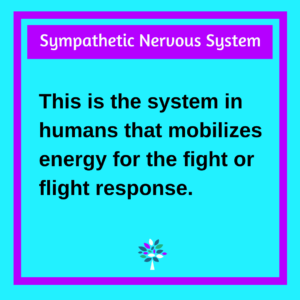Sympathetic Nervous System

I find that lack of information about how the body functions can lead to trauma survivor’s sense of guilt or shame for how they behaved at the time of the trauma. But many of these reactions are out of our conscious control. In the coming posts I will be reviewing information on what responses are the result of various parts of our nervous system, including the sympathetic, parasympathetic, dorsal vagal and ventral vagal system.
First up is the parasympathetic nervous system.
All mammals have developed an internal system that helps them in dangerous, life-or-death situations to provide enough energy for fight or flight.
This is something that happens automatically, without conscious thought ad allows your system to make quick internal adjustments and react without having to think about it.
Activation of this system increases heart rate so that you more blood is sent to your muscles.
Your breathing quickens so that there is more energy available to run or fight.
Your pupils dilate so that you can take in more of your environment and can scan for other signs of danger, escape routes, or allies to help.
Digestion is shut off as it is not necessary for running or fighting for your life. This is the reason that chronic stress and hypervigilance is associated with stomach and gastric problems.










